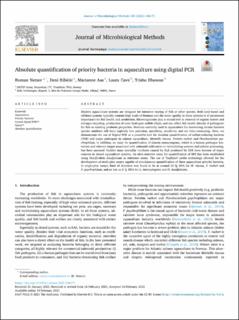| dc.contributor.author | Netzer, Roman | |
| dc.contributor.author | Ribicic, Deni | |
| dc.contributor.author | Aas, Marianne | |
| dc.contributor.author | Cavé, Laura | |
| dc.contributor.author | Dhawan, Trisha | |
| dc.date.accessioned | 2022-10-19T07:43:00Z | |
| dc.date.available | 2022-10-19T07:43:00Z | |
| dc.date.created | 2021-08-04T12:01:13Z | |
| dc.date.issued | 2021 | |
| dc.identifier.citation | Journal of Microbiological Methods. 2021, 183 . | en_US |
| dc.identifier.issn | 0167-7012 | |
| dc.identifier.uri | https://hdl.handle.net/11250/3026913 | |
| dc.description.abstract | Modern aquaculture systems are designed for intensive rearing of fish or other species. Both land-based and offshore systems typically contain high loads of biomass and the water quality in these systems is of paramount importance for fish health and production. Microorganisms play a crucial role in removal of organic matter and nitrogen-recycling, production of toxic hydrogen sulfide (H2S), and can affect fish health directly if pathogenic for fish or exerting probiotic properties. Methods currently used in aquaculture for monitoring certain bacteria species numbers still have typically low precision, specificity, sensitivity and are time-consuming. Here, we demonstrate the use of Digital PCR as a powerful tool for absolute quantification of sulfate-reducing bacteria (SRB) and major pathogens in salmon aquaculture, Moritella viscosa, Yersinia ruckeri and Flavobacterium psychrophilum. In addition, an assay for quantification of Listeria monocytogenes, which is a human pathogen bacterium and relevant target associated with salmonid cultivation in recirculating systems and salmon processing, has been assessed. Sudden mass mortality incidents caused by H2S produced by SRB have become of major concern in closed aquaculture systems. An ultra-sensitive assay for quantification of SRB has been established using Desulfovibrio desulfuricans as reference strain. The use of TaqMan® probe technology allowed for the development of multi-plex assays capable of simultaneous quantification of these aquaculture priority bacteria. In single-plex assays, limit of detection was found to be at around 20 fg DNA for M. viscosa, Y. ruckeri and F. psychrophilum, and as low as 2 fg DNA for L. monocytogenes and D. desulfuricans. | en_US |
| dc.language.iso | eng | en_US |
| dc.publisher | Elsevier | en_US |
| dc.rights | Navngivelse 4.0 Internasjonal | * |
| dc.rights.uri | http://creativecommons.org/licenses/by/4.0/deed.no | * |
| dc.subject | Absolute quantification | en_US |
| dc.subject | Naica™ | en_US |
| dc.subject | PCR™ | en_US |
| dc.subject | Crystal digital | en_US |
| dc.subject | Priority bacteria | en_US |
| dc.subject | Aquaculture | en_US |
| dc.title | Absolute quantification of priority bacteria in aquaculture using digital PCR | en_US |
| dc.type | Peer reviewed | en_US |
| dc.type | Journal article | en_US |
| dc.description.version | publishedVersion | en_US |
| dc.rights.holder | © 2021 The Author(s). Published by Elsevier B.V | en_US |
| dc.source.pagenumber | 10 | en_US |
| dc.source.volume | 183 | en_US |
| dc.source.journal | Journal of Microbiological Methods | en_US |
| dc.identifier.doi | 10.1016/j.mimet.2021.106171 | |
| dc.identifier.cristin | 1923823 | |
| dc.source.articlenumber | 106171 | en_US |
| cristin.ispublished | true | |
| cristin.fulltext | original | |
| cristin.qualitycode | 1 | |

